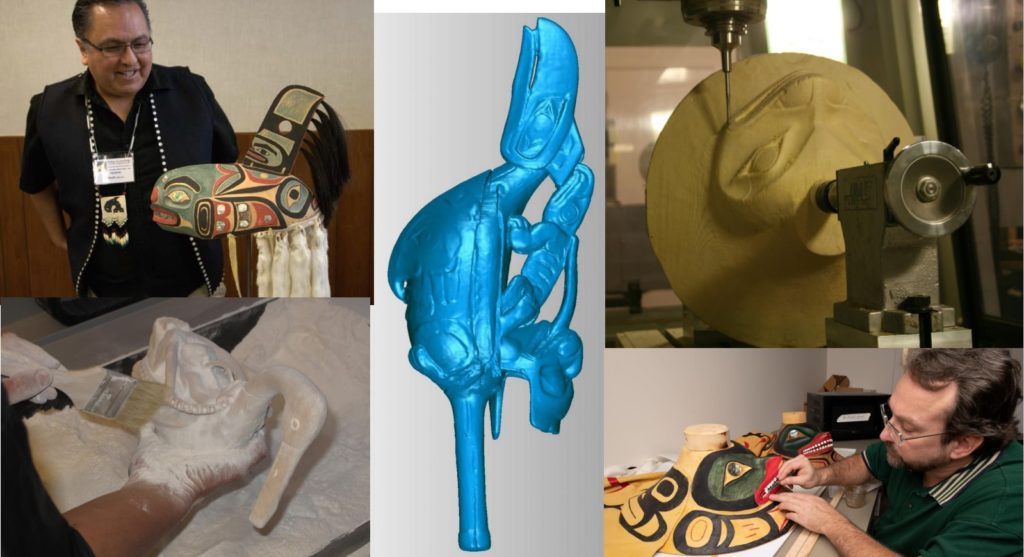
“Preserving Indigenous Culture Through 3-D Technologies” presented at the Washington Conservation Guild Virtual Meeting on February 3, 2022
Guest speakers:
- Vince Rossi, 3D Program Supervisor, Smithsonian Digitization Program Office
- Eric Hollinger, Repatriation Tribal Liaison, National Museum of Natural History (NMNH), Smithsonian Institution
- Carolyn Thome, Exhibits Specialist and Digital Model Maker, Smithsonian Institution
- Chris Hollshwander, Exhibits Specialist, Smithsonian Institution Exhibits
Moderated by: Gwen Manthey, Paintings Conservator, Smithsonian American Art Museum
The February WCG meeting hosted a robust round of presentations from a group of staff at the Smithsonian Institution, showcasing innovations and applications of 3-D technologies in cultural heritage, particularly for repatriated indigenous objects.
In an institution, such as the Smithsonian, only a select portion of the collections is on display to the public. The ability to digitally scan and model an object is inarguably indispensable for a vast and diverse collection, ranging from insects to spacecraft. Over the years, the Smithsonian Digitization Program Office (DPO) has begun using an automated photogrammetry workflow to make 3D scans of the collections, which are accessible to the public through an interactive online platform. Vince Rossi, the 3D Program Supervisor and the first speaker of the night, showcased the 3D model of Neil Armstrong’s spacesuit: the model can be explored through a guided tour or using the stratigraphic overlays, annotations (condition and treatment map can be leveraged onto the model), measurement, light, and slice (cross-section) tools. Vince also explored expanding the application of 3D models to augmented reality. For instance, students can now ‘drop’ a Mammuthus primigenius into a setting of their choice and interact with the model using their mobile devices.
The second presentation was led by Eric Hollinger, who detailed the experiences working with the indigenous communities as well the process and the opportunities beyond repatriation. Through several case studies, Eric explained that a 3D-printed replica can be used by both the indigenous communities and the museum as an effective teaching tool. Moreover, the replica may act as a means to handle otherwise spiritually and chemically hazardous objects (e.g. shamanic funerary objects thought to be imbued with spiritual essence and treated with mercury as a pesticide); a means to field-test a lost technology (i.e. after experimenting with replicas printed using high-strength nylon, Shee aan were confirmed to have been functional tools used to guide and propel spears); as well as a means to repair and reproduce a heavily damaged objects.
During the third session, Carolyn Thome discussed her role as the Digital Model Maker. Carolyn explained that the original CT data often needs different levels of fine-tuning and digital restoration before the model can be 3D-printed using gypsum-based powder and a liquid binder. These may include re-sculpting to remove any faults, mimicking the carving marks, filling in the missing areas, and isolating digital data for elements inside a hollow object (i.e. Carolyn highlighted a project involving a Tlingit rattle, where she processed the data for the stone beads separately from the rest of the rattle then added them to the cavity post-printing).
Chris Hollshwander then highlighted the process of producing replicas through computer numerical control (CNC) production. As a programmer and a modeler, Chris prepares files to direct the CNC milling machine, which employs a subtractive method compared to a 3D printer that uses an additive process of building up from fine layers of materials. In the particular case study that Chris highlighted–which was a collaboration between the Smithsonian and the Hoonah Indian Association–a block of wood was cut away using the milling machine to produce a replica of a dance wand, and then the finished model was carefully compared to the original object. After a comprehensive review, the digital files were then shared with the clan, who then used them to mill a second analogous reproduction. The second replica was sent to the Smithsonian for a side-by-side review with the first replica and the original artifact. The process proved to be beneficial, and it shows that indigenous communities that have access to 3D technologies can work in collaboration with museums to bring items in their collections back to the communities.
The talks concluded with a clip that showed the process of working directly with Southeast Alaskan clans to reproduce a heavily damaged clan crest hat. This included non-invasively documenting and digitizing the object; capturing information including the size, shape, and color; fine-tuning the data by digitally restoring missing parts; carving a wooden block (felled by the members of the clan) with a milling machine; painting with traditional materials, and returning the replica to the clan through a dedication ceremony.
The 3D technologies as modes of documenting, exploring, and handling objects open up new opportunities to reach a larger audience and expose a greater portion of collections to the future generation. As Vince reflected in the video, “when we 3D scan objects, they’ve had their story, and their story is often in the past…with this project, with 3D scanning an object, it’s beginning its new life.”
Summary by: Hae Min Park, Andrew W. Mellon Fellow in Paintings Conservation at the Walters Art Museum
Meeting attendance: 100 participants